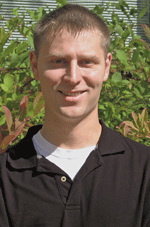Wood scientist and ALS user Jesse Paris is getting an intimate, 3-D view of adhesive penetration in wood-composite structures thanks to ALS Beamline 8.3.2. He and colleagues at Oregon State University are now using the data he gathered through x-ray tomography scans at the ALS to build a predictive computer simulation model that will allow future researchers to gain information about how certain wood species and adhesive types will interact.

“This model could allow adhesive and composite manufacturers, alike, to design products more efficiently for specific performance criteria, saving significant material costs,” says Paris.
Paris’s work is contributing to a growing U.S. industry—more than 95% of homes and a growing percentage of nonresidential structures are wood framed. With an increased demand for sustainable structures and efficient material use, the building industry is always looking for ways to extend their resources. Wood composites offer an opportunity to do this, saving building costs and in some cases increasing strength and durability. Technological advances are contributing to stronger, environmentally friendly composite materials that can be used in wood products such as furniture components or building materials.
Paris’s ALS research is funded by the Wood-Based Composites Center (WBC), an industry group consisting of members from the adhesives manufacturing and product manufacturing industries. The WBC feeds research programs at four different universities, one of which is Oregon State, where Paris is a fellow in the Wood Science and Engineering department within the College of Forestry. The National Science Foundation, recognizing that wood-composite development is something that will bolster the U.S. economy, matches the funding from the WBC.
“People in this industry are always looking for ways to improve their efficiency,” says Paris. “With composites we can enhance wood performance and extend the natural resource.”

Wood is an inherently variable product, which has always made mechanical and dimensional stability performances difficult to predict. Engineered composites can help minimize product variability, but also introduce complexity as they may be prepared from different wood species and adhesive types. When wood components are bonded together to form composites, the liquid adhesives flow into the hollow cells (lumens) making up the wood structure. The way that the adhesive flows from one lumen to the next is its penetration pattern, and this is controlled by manufacturing processes as well as numerous wood and adhesive properties.
“The nature of the adhesive penetration has a huge impact on the final product,” says Paris. “There is not yet a direct correlation between penetration depth and composite performance, but certainly some penetration is necessary to transfer joint stresses away from the bondline and into the bulk wood material.”
For decades, researchers have observed adhesive penetration with microscopes, but since that’s 2-D it has only told part of the story, as wood cells define a 3-D system. At the ALS, Paris is able to collect adhesive penetration data in 3-D and observe where the adhesive resides in the internal structure. As x-ray tomography is a nondestructive technique, the composite specimens are then preserved for subsequent joint performance testing. Paris plans to scan and test different wood species and different adhesives in combination to calibrate and test the robustness of the initial simulation model.
“For such a long time we’ve known that penetration affects composite performance, but it’s been an effect that’s been highly variable and difficult to quantify,” says Paris. “X-ray tomography is giving us data that’s so useful we’ll eventually be able to develop predictive models.”